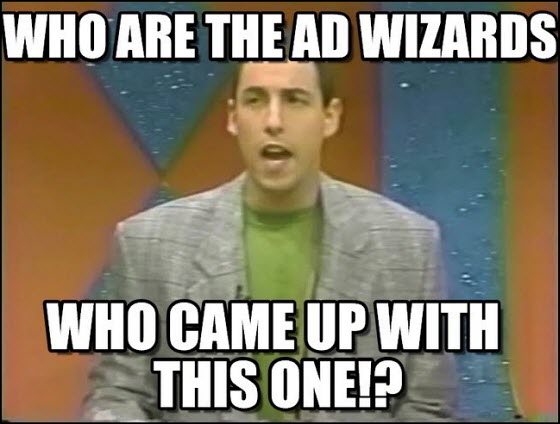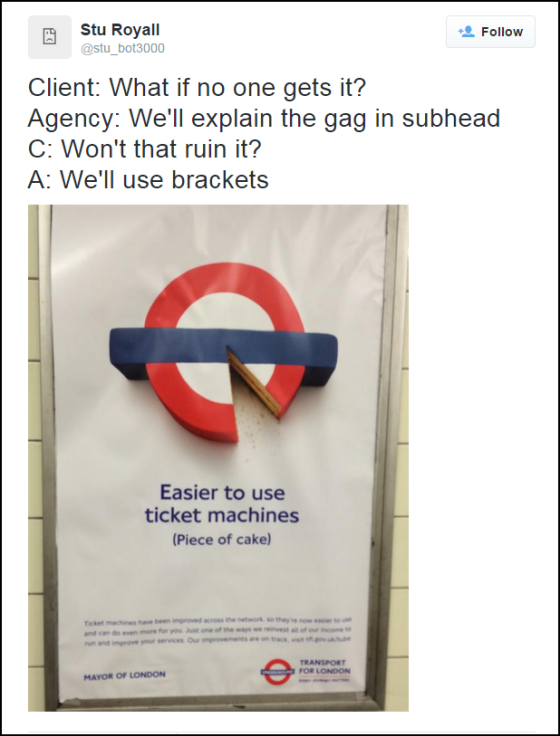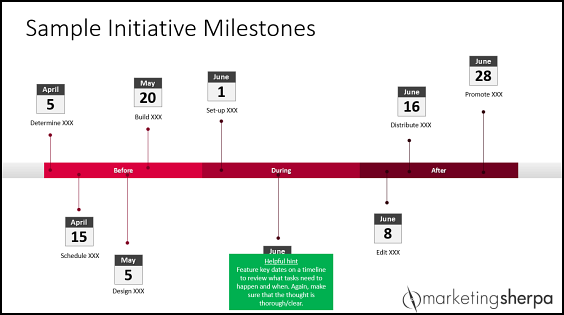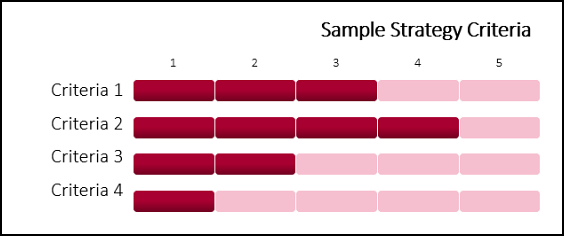How to Sell Your Marketing and Advertising Ideas to Your Boss and Clients (with free template)
Some ads, campaigns and branding ideas are pretty bad.
So much so that an old “Saturday Night Live” sketch — featuring Jerry Seinfeld playing the host of a “Jeopardy”-like show with stand-up comedians guessing the punch line — included the frequent answer from Adam Sandler’s character, “Who are the ad wizards who came up with this one!?”
Cold comfort, though, when your own advertising and marketing ideas don’t see the light of day: “How is that dreck getting made, while my brilliant ideas are being overlooked?”
To help you improve your batting average – whether you work for an agency or in a corporate marketing department – today’s MarketingSherpa blog post includes a few tips for presenting your campaign, in addition to marketing and advertising ideas to help you win budget, resources and approval. Plus, we’re even including a free PowerPoint template (click here to download) to help you the next time you pitch an idea.
Our own Pamela Jesseau, Senior Director of Marketing, MECLABS Institute (the parent research organization of MarketingSherpa) created the above template, and uses it with her team and agency. So I sat down with Pamela to get a few ideas for how you can sell your ideas (whether you use the template or not).
Step #1: Start with the objective
This may seem overly obvious, but you should begin at the beginning.
Well, it can’t be too obvious, because Simon Sinek turned Start with Why into a bestseller. I’ve been in many meetings where people just jump into a topic, and no one else in the room understands the goal of the meeting.
Executives and decision makers are notoriously impatient. You need to tell them why you’re taking up their valuable time to pitch to them.
This should, of course, start before the meeting. That’s how you get them there. However, they may be going from meeting to meeting and forget the bigger purpose you’re currently meeting about in that moment.
In addition to getting everyone in the meeting grounded and on the same page, starting with the objective has another benefit that Pamela brought up. By forcing yourself to type it out and put it into words on a PowerPoint slide, it focuses and clarifies your own thinking.
Step #2: Create the vision
To go back to Sinek for a moment: “Directions are instructions given to explain how. Direction is a vision offered to explain why.”
The objective of your plan is the micro “why,” but the macro “why” is the big picture vision you paint. This is your opportunity to capture the imagination of what are probably some pretty creative people in the room. Perhaps more creative than you give them credit for.
“I think it’s important to inspire. Both for yourself, and how you contribute to the customer if you’re doing customer-first marketing,” Pamela said. “What’s the mission? Help your audience or your boss see the potential.”
As you can see, what we’re doing here is much more than a meeting about a campaign plan. To truly get your campaigns executed, you must be able to create a persuasive presentation, something we sometimes only reserve for external audiences and overlook when speaking within our own company.
So who better to ask for advice than Nancy Duarte, CEO, Duarte Design. Nancy wrote the “Harvard Business Review Guide to Persuasive Presentations” and worked on perhaps one of the most famous slideshows ever — Al Gore’s “An Inconvenient Truth.”
I asked Nancy for some advice for marketers trying to sell their campaigns and marketing ideas internally and to clients.
“You need to start with ‘what is’ — the current state of things — and then move to ‘what could be,’ which would be the result if they implement your idea,” Nancy said.
“Your goal is to make the future so much more alluring than the current state of things so that the status quo seems undesirable. You want to fill the audience with a heightened state of ‘what could be’ so that they are willing to be transformed and take action to help create the new future you are proposing.”
Step #3: Don’t overlook the obstacles
If it was easy, someone would have already done it by now.
There is likely a pain that has spurred you to come up with this idea, campaign or ad concept. Nancy refers to is as the “what is” or “status quo.” In addition, if your ideas call for change of any kind, keep in mind that change is painful and scary.
“Change requires a breaking down before a building up, and this is where your audience will need help most of all. You need to acknowledge the sacrifice and the risk that the audience is taking if they adopt your idea,” Nancy said.
“In order to overcome their resistance, you have to make the reward (new bliss) worth it. You need to clearly articulate that their sacrifice and risk will be rewarded with some kind of benefit to them, their sphere or, perhaps, all of mankind.”
As a writer, I personally like the analogy of the hero’s journey (also know as the monomyth). According to Joseph Campbell, narrative storytelling includes a “call to adventure” that sends our hero on her journey. On the grandest scale, Odysseus sets out to return home from the Trojan war and Luke Skywalker meets some droids and sees a hologram about a princess that needs help.
You can use this call to adventure to get your clients, your business leaders and your decision makers to make that scary change and buy into your campaign ideas.
“’Why should I care about this thing?’ You want your boss or your client to be reminded of the pain that needs to be addressed,” Pamela explained. “Because we all have lot of things we could be working on. Why this idea, why this solution, why now?”
Step #4: Paint the picture
Now that you’ve laid the groundwork for your ideas and campaigns, it’s time to get back to “what could be,” but with more granularity this time.
Show the different concepts — the strategic approach — explain the thinking behind each approach, and show the plan for rolling it out.
What campaigns will you be talking about in the presentation? And how will they roll out?
“[Even in meetings], people want to know ‘Where am I? What can I do here? Where should I do it?‘” Pamela said. “Give them a roadmap where they’re going.”
The free template includes questions and design elements that will help you paint the picture of important aspects of the campaigns and ideas you’re pitching. Again, another benefit of filling this PowerPoint template out beforehand is that it makes you think through some key questions, improving not just your communication of your ideas, but the ultimate execution of them when you roll them out.
Step #5: Set and communicate objective criteria
“For each one, have some kind of objective criteria. It gives you a framework for why you chose this [idea or campaign] over another,” Pamela said. “For example, if I’m talking about which event to engage with, I’m going to look at reach and investment and quality of attendance. It gives me an apples-to-apples comparison so I’m not just choosing the campaign or recommendation based on gut. It shows your boss or client that you’ve thought through the pieces.”
Step #6: Discuss the expected results
As Stephen Covey says, “Begin with the end in mind.”
How will you measure success?
Having a specific, numeric forecast you can then measure success against is great (bonus: it will build your credibility and help sell all your future efforts if you meet or exceed these forecasts).
If you can’t forecast with reliability, at least include current data (traffic, leads, sales, etc.) and project what some results might be expected at possible conversion rates to provide solid examples.
If numeric results aren’t appropriate for your idea or campaign, include the resulting experience you’re trying to generate in potential customers. What will they think or feel after your campaign that they didn’t before your campaign? How will you know you’ve been successful?
Step #7: The ask
This is your call-to-action. What are the immediate next steps you need to make your plan happen?
If some are internal and some are external — either from a different department or a different company entirely (like your client, agency, a partner, another vendor, etc) — be clear about who needs to do what and when.
You might want to even include a timeline or strategic plan calendar with specific dates and times to be very clear about next steps.
Your goal is to get the resources you need to execute at the moment they’ll be most open to providing them – right after you did an amazing job selling your ideas. Plus, many business leaders might expect the campaign to instantly (and magically) happen the moment after they say “yes.” Showing them what it takes to make it happen will show the cost (in time, budget, etc.) to go along with the value you expect to provide.
Now it’s your turn
Download the free presentation template and start selling your ideas. Let us know how it worked for you, what improvements you made to it and what you learned.
“Part of it is just showing your boss [or client] that you’ve done the work and thought it through. They may have feedback, but they’ll be able to follow your thinking.” Pamela said. “The fact that you’re so organized will go a long way, even in generating discussion that leads to the perfect plan. Ultimately, the success of this template is that it becomes a working document that you can build your project plan off of.”
You can follow Daniel Burstein, Director of Editorial Content, MarketingSherpa, @DanielBurstein.
You might also like
Take 15 minutes to complete the 2015 MarketingSherpa Marketing Practices Survey, and get a free pre-release copy of the August 2015 MarketingSherpa Consumer Purchase Preference Survey plus a chance to win a free, three-day ticket to MarketingSherpa Summit 2016 in Las Vegas OR an iPad Air 2. The deadline is September 28.
Subscribe to MarketingSherpa Best of the Week newsletter — Get the best marketing ideas from your peers in your inbox every week, to help spur your own campaign ideas
How to Write a Competitive Analysis (with 3 free templates)
Rhetoric isn’t a bad thing—16 Rhetorical Devices Regularly Used by Steve Jobs (by Nancy Duarte)
Internal Marketing: B2B’s employee-exclusive video series fosters team morale
Internal Marketing: The 3 people you must sell to in your own office
MarketingSherpa Summit 2016 — February 22-24 in Las Vegas
Categories: Marketing Internal marketing, PowerPoint














